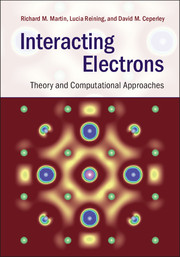Book contents
- Frontmatter
- Dedication
- Contents
- Preface
- Acknowledgments
- Notation
- Part I Interacting electrons: beyond the independent-particle picture
- Part II Foundations of theory for many-body systems
- Part III Many-body Green's function methods
- 9 Many-body perturbation theory: expansion in the interaction
- 10 Many-body perturbation theory via functional derivatives
- 11 The RPA and the GW approximation for the self-energy
- 12 GWA calculations in practice
- 13 GWA calculations: illustrative results
- 14 RPA and beyond: the Bethe–Salpeter equation
- 15 Beyond the GW approximation
- 16 Dynamical mean-field theory
- 17 Beyond the single-site approximation in DMFT
- 18 Solvers for embedded systems
- 19 Characteristic hamiltonians for solids with d and f states
- 20 Examples of calculations for solids with d and f states
- 21 Combining Green's functions approaches: an outlook
- Part IV Stochastic methods
- Part V Appendices
- References
- Index
20 - Examples of calculations for solids with d and f states
from Part III - Many-body Green's function methods
Published online by Cambridge University Press: 05 June 2016
- Frontmatter
- Dedication
- Contents
- Preface
- Acknowledgments
- Notation
- Part I Interacting electrons: beyond the independent-particle picture
- Part II Foundations of theory for many-body systems
- Part III Many-body Green's function methods
- 9 Many-body perturbation theory: expansion in the interaction
- 10 Many-body perturbation theory via functional derivatives
- 11 The RPA and the GW approximation for the self-energy
- 12 GWA calculations in practice
- 13 GWA calculations: illustrative results
- 14 RPA and beyond: the Bethe–Salpeter equation
- 15 Beyond the GW approximation
- 16 Dynamical mean-field theory
- 17 Beyond the single-site approximation in DMFT
- 18 Solvers for embedded systems
- 19 Characteristic hamiltonians for solids with d and f states
- 20 Examples of calculations for solids with d and f states
- 21 Combining Green's functions approaches: an outlook
- Part IV Stochastic methods
- Part V Appendices
- References
- Index
Summary
In sp solids, correlation effects are not immediately striking, while for the df solids, they are glaringly present.
L. Hedin, J. Phys.: Condens. Matter11, R489–R528 (1999)Summary
The topics of this chapter are chosen to represent significant classes of materials and phenomena, often called “strongly correlated.” Lanthanides and actinides illustrate striking effects such as volume collapse, heavy fermions, and localized-todelocalized transitions. Transition metals, such as Fe and Ni, are classic problems with both band-like and local moment behavior. Transition metal oxides exhibit a vast array of phenomena including metal–insulator transitions and high–low spin transitions. These are difficult problems involving competing interactions; the examples here and in Ch. 13 are not chosen to demonstrate successes, but rather to illustrate capabilities of different approaches.
This chapter is devoted to representative examples that bring out the range of phenomena observed in materials with strong local atomic-like interactions, and the types of properties that can be calculated with various methods. The foremost examples are elements and compounds of the series of transition elements with d and f states that are localized as depicted in Fig. 19.1. As emphasized in the previous chapter, the theory must deal with the complexities of many competing interactions: direct Coulomb, exchange, spin–orbit, crystal field splitting, hybridization with other orbitals, and other effects, all of which may be essential for understanding any particular material.
Many-body perturbation theory, especially the GW approximation and beyond, is a firstprinciples method that can be applied directly to ordered states at low temperature. Several examples of applications to transition metal systems are given in Ch. 13 and referred to here to provide a unified picture. Density functional theory and approximate static mean-field approximations also provide useful results and insights. However, many of the most striking phenomena can be understood only by taking into account strong correlation, including large renormalization of electronic states, satellites in excitation spectra, magnetic phase transitions, metal–insulator transitions, and other phenomena. Many phenomena can be understood only if temperature is taken into account. Dynamical mean-field theory brings this capability, but at a price because it is feasible to treat explicitly only a small subset of the degrees of freedom of the electrons. All the results presented here are done in the single-site approximation (single-site DMFA), except the two-site cluster for VO2 in Sec. 20.6.
- Type
- Chapter
- Information
- Interacting ElectronsTheory and Computational Approaches, pp. 527 - 552Publisher: Cambridge University PressPrint publication year: 2016



